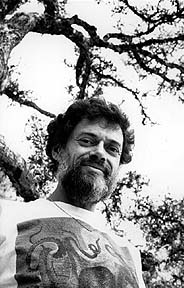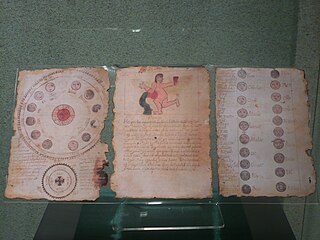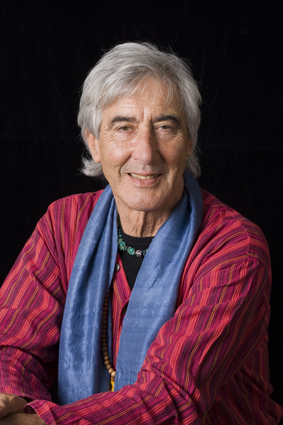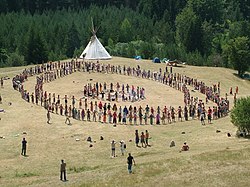Hunab Ku is a colonial period Yucatec Maya reducido term meaning "The One God". It is used in colonial, and more particularly in doctrinal texts, to refer to the Christian God. Since the word is found frequently in the Chilam Balam of Chumayel, a syncretistic document heavily influenced by Christianity, it refers specifically to the Christian God as a translation into Maya of the Christian concept of one God, used to enculturate the previously polytheist Maya to the new religion.

Popol Vuh is a text recounting the mythology and history of the Kʼicheʼ people of Guatemala, one of the Maya peoples who also inhabit the Mexican states of Chiapas, Campeche, Yucatan and Quintana Roo, as well as areas of Belize, Honduras and El Salvador.

Terence Kemp McKenna was an American ethnobotanist and mystic who advocated the responsible use of naturally occurring psychedelic plants. He spoke and wrote about a variety of subjects, including psychedelic drugs, plant-based entheogens, shamanism, metaphysics, alchemy, language, philosophy, culture, technology, ethnomycology, environmentalism, and the theoretical origins of human consciousness. He was called the "Timothy Leary of the '90s", "one of the leading authorities on the ontological foundations of shamanism", and the "intellectual voice of rave culture".
Pseudoarchaeology—also known as alternative archaeology, fringe archaeology, fantastic archaeology, cult archaeology, and spooky archaeology—is the interpretation of the past by people who are not professional archaeologists and who reject or ignore the accepted data gathering and analytical methods of the discipline. These pseudoscientific interpretations involve the use of artifacts, sites or materials to construct scientifically insubstantial theories to strengthen the pseudoarchaeologists' claims. Methods include exaggeration of evidence, dramatic or romanticized conclusions, use of fallacious arguments, and fabrication of evidence.

Kʼinich Janaab Pakal I, also known as Pacal or Pacal the Great, was ajaw of the Maya city-state of Palenque in the Late Classic period of pre-Columbian Mesoamerican chronology. He acceded to the throne in July 615 and ruled until his death. Pakal reigned 68 years—the fifth-longest verified regnal period of any sovereign monarch in history, the longest in world history for more than a millennium, and still the longest of any residing monarch in the history of the Americas. During his reign, Pakal was responsible for the construction or extension of some of Palenque's most notable surviving inscriptions and monumental architecture. Pakal is perhaps best known in popular culture for his depiction on the carved lid of his sarcophagus, which has become the subject of pseudoarchaeological speculations.

The Harmonic Convergence was the world's first synchronized global peace meditation, coinciding with an exceptional alignment of Solar System planets on August 16–17, 1987. The event was organized by spouses José Argüelles and Lloydine Burris Argüelles, via the Planet Art Network (PAN), a peace movement they founded in 1983. Timing of the Harmonic Convergence allegedly marked a significant celestial alignment of the Sun, Moon, and six planets as "part of the grand trine."

The Books of Chilam Balam are handwritten, chiefly 17th and 18th-centuries Maya miscellanies, named after the small Yucatec towns where they were originally kept, and preserving important traditional knowledge in which indigenous Maya and early Spanish traditions have coalesced. They compile knowledge on history, prophecy, religion, ritual, literature, the calendar, astronomy, and medicine. Written in the Yucatec Maya language and using the Latin alphabet, the manuscripts are attributed to a legendary author called Chilam Balam, a chilam being a priest who gives prophecies and balam a common surname meaning ʼjaguarʼ. Some of the texts actually contain prophecies about the coming of the Spaniards to Yucatán while mentioning a chilam Balam as their first author.

Abbé Charles-Étienne Brasseur de Bourbourg was a noted French writer, ethnographer, historian, archaeologist, and Catholic priest. He became a specialist in Mesoamerican studies, travelling extensively in the region. His writings, publications, and recovery of historical documents contributed much to knowledge of the region's languages, writing, history and culture, particularly those of the Maya and Aztec civilizations. However, his speculations concerning relationships between the ancient Maya and the lost continent of Atlantis inspired Ignatius L. Donnelly and encouraged the pseudo-science of Mayanism.

José Argüelles was an American New Age writer and artist. He was the co-founder, along with Lloydine Argüelles, of the Planet Art Network and the Foundation for the Law of Time. As one of the originators of the Earth Day concept, Argüelles founded the first Whole Earth Festival in 1970, at Davis, California.

Augustus Henry Julian Le Plongeon was a British-American archeologist and photographer who studied the pre-Columbian ruins of America, particularly those of the Maya civilization on the northern Yucatán Peninsula. While his writings contain many notions that were not well received by his contemporaries and were later disproven, Le Plongeon left a lasting legacy in his photographs documenting the ancient ruins. He was one of the earliest proponents of Mayanism.

Daniel Pinchbeck is an American author. His books include Breaking Open the Head: A Psychedelic Journey into the Heart of Contemporary Shamanism, 2012: The Return of Quetzalcoatl, and Notes from the Edge Times. He is a co-founder of the web magazine Reality Sandwich and of the website Evolver.net, and edited the North Atlantic Books publishing imprint Evolver Editions. He was featured in the 2010 documentary 2012: Time for Change, directed by Joao Amorim and produced by Mangusta Films. He is the founder of the think tank Center for Planetary Culture, which produced the Regenerative Society Wiki.
A kʼatun is a unit of time in the Maya calendar equal to 20 tuns or 7200 days, equivalent to 19.713 tropical years. It is the second digit on the normal Maya long count date. For example, in the Maya Long Count date 12.19.13.15.12, the number 19 is the kʼatun. There are 20 k'atuns in a baktun.

The Dreamspell is an esoteric calendar in part inspired by the Maya calendar by New Age spiritualist, Mayanist philosopher, and author José Argüelles and Lloydine Burris Argüelles. The Dreamspell calendar was initiated in 1987 and released as a board game in 1990.
William Andrew "Bill" Saturno is an American archaeologist and Mayanist scholar who has made significant contributions toward the study of the pre-Columbian Maya civilization. Saturno is a former director of the Proyecto San Bartolo-Xultun at the Instito de Antropologia e Historia in Guatemala, a former national space research scientist at the Marshall Space Flight Center, and a research associate at the Peabody Museum at Harvard University. Saturno has previously worked as an Assistant Professor of Archaeology at Boston University and MIT and as a lecturer at the University of New Hampshire.

The 2012 phenomenon was a range of eschatological beliefs that cataclysmic or transformative events would occur on or around 21 December 2012. This date was regarded as the end-date of a 5,126-year-long cycle in the Mesoamerican Long Count calendar, and festivities took place on 21 December 2012 to commemorate the event in the countries that were part of the Maya civilization, with main events at Chichén Itzá in Mexico and Tikal in Guatemala.
Frank Waters was an American writer. He is known for his novels and historical works about the American Southwest. The Frank Waters Foundation, founded in his name, strives to foster literary and artistic achievement in the Southwest United States.
John Major Jenkins was an American author and pseudoscientific researcher. He is best known for his works that theorize certain astronomical and esoteric connections of the calendar systems used by the Maya civilization of pre-Columbian Mesoamerica. His writings are particularly associated with 2012 millenarianism and the development of Mayanism in contemporary and popular culture, as an outgrowth from the New Age milieu. He is one of the principal figures who have promoted the idea that the ancient Maya calendar ends on 21 December 2012 and that this portended major changes for the Earth. He has self-published a number of books through his Four Ahau Press.
Tony Shearer was an American Mayanism proponent and New Age author. His work contributed to the modern popularization of syncretic beliefs based on Maya calendrics and the purported significance of dates in August 1987 and December 2012.
Carl Johan Calleman,, is a toxicologist as well as an author and speaker on the millenarian New Age interpretation of the Mayan calendar known as Mayanism. He differs from professional Mayanists in seeing 28 October 2011 and not 21 December 2012 as a significant date. Calleman does not interpret the date as an apocalypse, Armageddon, or other cataclysmic event but a slow transformation of consciousness in which people experience a higher "unity consciousness."
Queen Moo is a mythical Mayan queen written about by Augustus Le Plongeon and his wife, Alice Dixon Le Plongeon. The Plongeons undertook the first excavation of Chichen Itza in 1875, and based their theories about Queen Moo on the murals and inscriptions that they found there. It is generally accepted that Plongeon's theories are not supported by the archaeological evidence.











